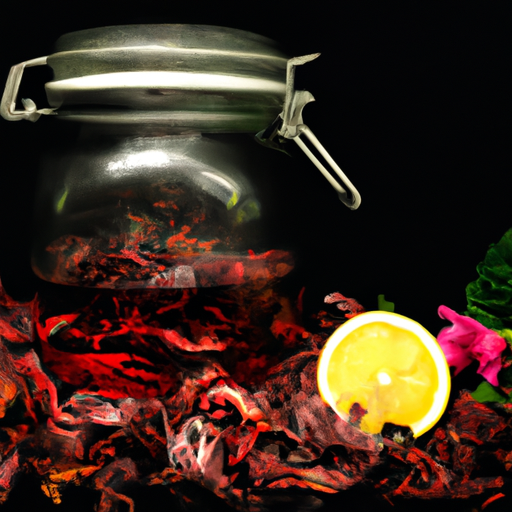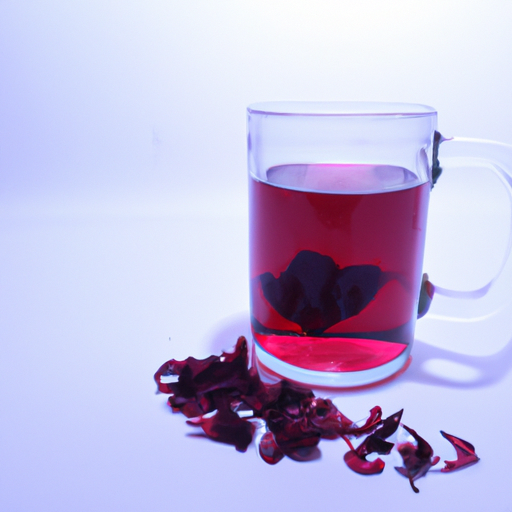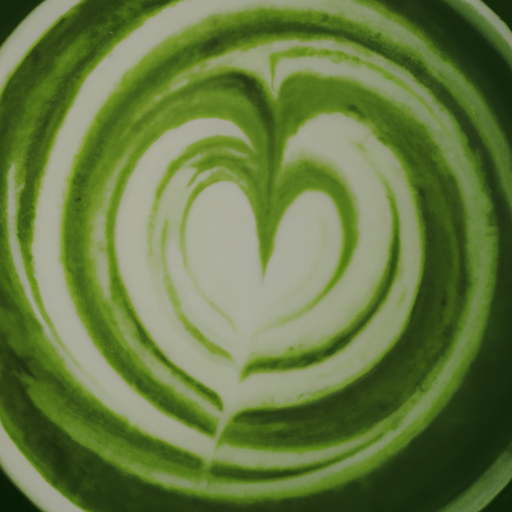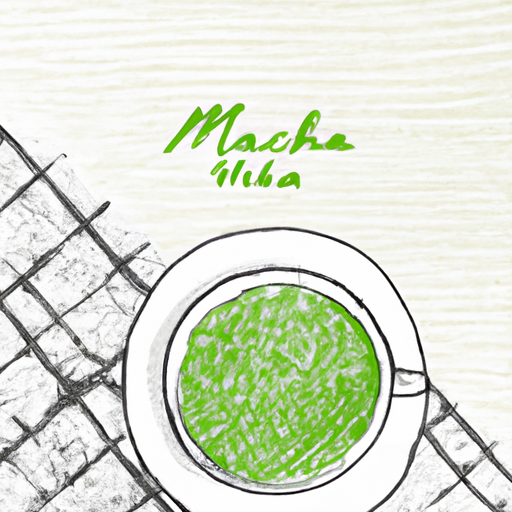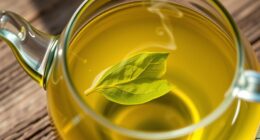I really enjoy a cool glass of hibiscus tea during the warm summer months. It has a sour, sweet flavor and is full of antioxidants. What’s even better? It’s simple to prepare at home with only a handful of ingredients!
To start, you’ll need dried hibiscus flowers (also known as sorrel or jamaica), water, and your preferred sweetener. I recommend using honey or agave nectar for a natural touch of sweetness.
Once you have everything you need, follow these simple steps to brew your own delicious hibiscus tea that’s sure to impress your taste buds!
Key Takeaways
- Making hibiscus tea requires dried hibiscus flowers, water, and sweetener such as honey or agave nectar.
- The ideal temperature for brewing hibiscus tea is 200°F (93°C); use 1 tbsp of dried hibiscus flowers per 8 oz (236ml) of hot water.
- Hibiscus tea offers numerous health benefits, including boosting the immune system, lowering blood pressure, and protecting against illnesses and infections.
- Hibiscus tea can be stored in an airtight container in a cool, dry place for weeks or months, and can be enjoyed hot or iced with different flavor combinations and garnishes.
Gather Your Ingredients
Now, let’s get our ingredients ready by grabbing some dried hibiscus flowers and a few other key items from the kitchen! You can use either fresh or dried hibiscus flowers to make this tea, but using dried flowers is often more convenient and easier to find at your local grocery store.
When selecting your hibiscus flowers, make sure they are vibrant in color and free of any mold or signs of spoilage. You’ll also need water, sweetener (optional), and a strainer or cheesecloth for filtering out the solids later on.
Once you have all your ingredients gathered, it’s time to move onto preparing your water. To prepare your water, fill a pot with about 8 cups of water and bring it to a boil over high heat. Once boiling, remove the pot from heat and add in 1 cup of dried hibiscus flowers. Stir well and let steep for about 10-15 minutes until the mixture has cooled down slightly. Then strain out the solids using a fine mesh strainer or cheesecloth into another container.
Now that we’ve got our water ready with infused flavors from the hibiscus flower petals, it’s time to move on to sweetening our homemade tea!
Preparing Your Water
First, you’ll want to fill your pot with water and bring it to a boil. Boiling water is crucial in making homemade hibiscus tea as it helps extract the flavors and nutrients from the hibiscus flowers. However, some people prefer using filtered water instead of tap water because of its better taste and purity.
Whatever your preference may be, make sure the water is clean and free from any impurities. To ensure great-tasting tea, pay attention to the temperature of your boiling water. The ideal temperature for brewing hibiscus tea is around 200°F (93°C). If you’re unsure about the temperature, use a thermometer or wait until you see small bubbles forming at the bottom of the pot.
Avoid boiling your water for too long as this can cause it to lose oxygen, which affects its taste and quality. Once your water has reached the desired temperature, turn off the heat and get ready to add your hibiscus flowers.
But before we proceed to that step, there’s one more important thing you need to know – how much water you should use per serving of tea. Typically, one tablespoon of dried hibiscus flowers requires eight ounces (236ml) of hot water.
Now that you’ve got everything prepared, let’s move on to adding our main ingredient – hibiscus flowers!
Adding the Hibiscus Flowers
Now that we’ve prepared our water, it’s time to add the star ingredient – hibiscus flowers!
To make sure I get the perfect amount, I measure out 1/4 cup of dried hibiscus flowers.
Then, I carefully add them to my pot of simmering water and let them infuse for about 10-15 minutes until the tea turns a deep shade of red.
Infusing the tea properly allows all of those delicious flavors and nutrients from the hibiscus to be extracted into our drink.
Measuring the Flowers
Before you start brewing, grab your measuring cup and scoop two tablespoons of dried hibiscus flowers into a tea strainer. Flower selection is crucial in making the best hibiscus tea. You may use fresh or dried flowers, but I prefer using the latter as it has a stronger flavor.
When selecting your flowers, make sure they are bright red and free from any mold or discolorations. If you can’t find dried hibiscus flowers in your local store, don’t worry! There are alternative options such as using hibiscus tea bags or buying them online.
To make the most flavorful hibiscus tea, it’s important to measure the amount of flowers accurately. Using too much can result in an overpowering taste while using too little can lead to a weak brew. So why not follow these three simple steps that will guarantee perfect measurement every time?
First, remember to fluff up the dried flowers before scooping them into your measuring cup. Second, level off the top with a knife or spoon to ensure accurate measurements. Finally, add two tablespoons of the flowers into your tea strainer and get ready for some delicious homemade hibiscus tea!
Now that we have measured our ingredients perfectly, let’s move on to infusing our tea for ultimate flavor extraction!
Infusing the Tea
So, you’re ready to let those lovely hibiscus flowers steep in hot water and unleash their delicious flavor into your cup. After measuring out the desired amount of dried hibiscus flowers, it’s time to infuse them with boiling water.
I usually use a teapot or a heat-resistant pitcher for this step. As the hot water pours over the flowers, their beautiful crimson color will begin to seep out and create a vibrant brew. The longer you let the tea steep, the stronger its flavor will become.
If you want to experiment with different flavor combinations, try adding some sliced ginger or a sprig of fresh mint to your infusion. Not only do these ingredients add an extra layer of taste, but they also offer their own health benefits.
Once your tea has reached your preferred strength, it’s time to move onto sweetening it up!
Sweetening Your Tea
To add a touch of sweetness to your homemade hibiscus tea, you can stir in some honey or agave nectar. These natural alternatives not only enhance the flavor of the tea, but also offer health benefits.
Honey is known for its antibacterial properties and immune-boosting effects, while agave nectar has a lower glycemic index than sugar and may help regulate blood sugar levels. When sweetening your tea, it’s important to start with a small amount and adjust to taste.
Too much sweetness can overpower the tartness of the hibiscus and detract from its unique flavor profile. I like to start with a teaspoon of honey or agave nectar per cup of tea and go from there. Once you’ve added your preferred sweetener, give the tea a good stir until it’s fully dissolved.
Now that your homemade hibiscus tea is perfectly sweetened, it’s time to move on to straining out any remaining solids before enjoying this refreshing beverage.
Straining Your Tea
Now that you have added your sweetener of choice, use a fine mesh strainer to remove any remaining petals or solids from the tea for a smooth and enjoyable sip. There are different ways to strain your hibiscus tea, but using a fine mesh strainer is the most effective one. This will ensure that all the loose leaves are removed and only clear liquid remains.
Timing is key when it comes to straining your tea. The best time to strain hibiscus tea is right after boiling and steeping it for 5-10 minutes. If you leave it too long, the solids will start breaking down and may make the drink taste bitter. On the other hand, if you strain it too soon, you might not extract enough flavor from the petals.
Once your tea has been strained, transfer it into a pitcher or individual glasses filled with ice cubes for a refreshing beverage perfect for summer days. Now that your tea is ready to serve, let’s move on to the next step: serving your homemade hibiscus tea.
| Straining Methods | Pros | Cons |
|---|---|---|
| Fine Mesh Strainer | Effectively removes solids and produces smooth texture | Requires extra equipment |
| Cheesecloth | Can catch even small particles | Tedious process and can be messy |
| Infuser Basket/Teapot Filter | Convenient option for loose leaf teas | May not remove all solid particles |
| Overall, the best straining method depends on the specific application and desired outcome. |
Serving Your Tea
Now that I’ve strained my homemade hibiscus tea, it’s time to serve it up!
The first decision is whether to enjoy it hot or iced. Personally, I prefer mine over ice, especially on a hot day.
Next, consider adding garnishes such as fresh mint leaves or a slice of lemon for an extra burst of flavor and visual appeal.
Hot vs. Iced
Sipping on a refreshing glass of iced hibiscus tea under the shade of a tree is the perfect way to cool off on a hot summer day. Not only does it quench your thirst, but it also provides numerous health benefits.
Here are three reasons why you should try iced hibiscus tea:
-
Hydration: Staying hydrated is crucial during the hot summer months, and iced hibiscus tea can help with that. It’s a great alternative to sugary drinks and sodas which can dehydrate you.
-
Immunity boost: Hibiscus flowers contain antioxidants that can help strengthen your immune system, protecting against illnesses and infections.
-
Lowers blood pressure: Studies have shown that drinking hibiscus tea regularly may help lower blood pressure levels in people with hypertension.
As much as I love my iced hibiscus tea, sometimes I do prefer it hot on cooler days or when I need something warm and soothing for my throat.
But before we move onto adding garnishes to our homemade brew, let me tell you about how to make this delicious drink both hot and cold!
Adding Garnishes
Adding garnishes to your glass of iced or hot hibiscus tea can enhance the flavor and add a touch of creativity to your drink. One simple and refreshing idea is to add fresh mint leaves. They not only bring a delightful aroma but also complement the tangy taste of hibiscus. Simply tear off a few leaves and drop them into your tea before enjoying.
If you’re feeling more adventurous, try adding slices of citrus fruit like lemon or lime for an extra zesty kick. Alternatively, you could infuse your tea with other herbs such as lavender, rosemary, or basil for a unique twist on your usual cuppa. The possibilities are endless when it comes to using garnishes to elevate the flavor of hibiscus tea!
Now that you know how to add some pizzazz to your homemade hibiscus tea, let’s move onto the next step. You can store it properly so that you can enjoy its deliciousness at any time.
Storing Your Hibiscus Tea
To maintain the freshness and quality of your homemade hibiscus tea, you should store it in an airtight container in a cool, dry place. This is particularly important if you’re planning on long-term storage or if you’ve made a large batch that won’t be consumed immediately.
Here are some tips to help preserve the freshness of your hibiscus tea:
-
Keep it away from light: Hibiscus tea can lose its flavor and color when exposed to light for prolonged periods. Store it in a dark cupboard or pantry.
-
Don’t mix with other flavors: If you want to add different flavors to your hibiscus tea, do so only when serving it. Mixing flavors before storing can alter and diminish the taste of the tea.
-
Avoid moisture: Moisture can affect the quality of your hibiscus tea by causing mold or bacteria growth. Make sure the container is completely dry before filling it with your tea.
-
Label and date: It’s always good practice to label and date any homemade food products that are stored for future use. This will help ensure that you know how long they have been stored and whether they are still safe to consume.
By following these guidelines, you’ll be able to enjoy fresh-tasting hibiscus tea for weeks or even months after making it. With proper storage, you can experiment with different flavor variations without worrying about losing the quality of your base tea blend. Speaking of experimenting with flavor variations…
Experimenting with Flavor Variations
If you’re looking to spice up your tea routine, why not try mixing in some different flavors with your hibiscus base? Hibiscus tea is already known for its tart and tangy taste, but by experimenting with flavor combinations, you can create a unique and personalized drink that suits your tastes.
One popular flavor combination is hibiscus and ginger. Ginger adds a spicy kick to the sweet and sour notes of hibiscus. It also has numerous health benefits such as aiding digestion, reducing inflammation, and boosting the immune system.
Another great addition is cinnamon, which gives the tea a warm and comforting aroma while providing antioxidant benefits.
For those who prefer fruity flavors, adding berries such as strawberries or raspberries can enhance the natural sweetness of hibiscus. These fruits are rich in vitamin C and antioxidants that help improve heart health.
Lemon or lime juice can also be added for an extra zingy burst of citrusy flavor that complements the tartness of hibiscus.
By experimenting with different flavor combinations, you can transform your homemade hibiscus tea into a deliciously refreshing beverage full of health benefits. Mix things up by trying out new ingredients until you find your perfect blend!
Frequently Asked Questions
How long does hibiscus tea last in the refrigerator?
I recently made a batch of hibiscus tea and was left wondering about its shelf life. After doing some research, I found that hibiscus tea can last for up to one week in the refrigerator if stored properly.
To preserve it, make sure to transfer the tea into an airtight container or bottle and store it in the coldest part of the fridge. If you notice any changes in color or smell, it’s best to discard it.
Overall, storing hibiscus tea is fairly simple as long as you follow these guidelines and keep an eye on its freshness.
Can you use dried hibiscus flowers instead of fresh ones?
Dried vs Fresh: Which is better for making hibiscus tea?
In my experience, both dried and fresh hibiscus flowers work well in making tea. The main difference is in the flavor intensity. Dried flowers have a more concentrated flavor, while fresh ones are milder.
I personally prefer using dried flowers as they require less storage space and can be kept for longer periods without spoiling. However, if you have access to fresh hibiscus flowers, that’s great too! Just keep in mind that you may need to use more of them to achieve the desired flavor strength.
Where to buy quality dried hibiscus flowers for tea making? You can find them at health food stores or online retailers like Amazon or Etsy. Make sure to read reviews before purchasing to ensure that you’re getting a high-quality product.
Is hibiscus tea safe for pregnant women to drink?
During pregnancy, it’s important to be cautious about what you consume. While hibiscus tea has many benefits for pregnant women such as reducing high blood pressure and promoting digestion, excessive consumption can have negative effects.
It’s recommended that pregnant women drink no more than one or two cups of hibiscus tea per day. Some potential risks of excessive consumption include uterine contractions which could lead to early labor or miscarriage, and a decrease in iron absorption which could lead to anemia.
So while hibiscus tea can be a healthy addition to a pregnancy diet in moderation, it’s important to consult with your doctor before consuming any new food or beverage during pregnancy.
Can you add other herbs or spices to the tea for added flavor?
Herbal combinations and flavorful additions are a great way to enhance the taste of hibiscus tea. In my experience, I’ve found that adding fresh ginger or a cinnamon stick can give the tea a warm and spicy kick.
Alternatively, adding some mint leaves or lemon juice can bring out its refreshing qualities. You could also try mixing it with other herbal teas like chamomile or lavender for a unique blend of flavors.
It’s important to note that while these additions can be delicious, they may also alter the medicinal properties of the tea. So it’s best to consult with a healthcare professional before trying any new combinations.
Does hibiscus tea have any health benefits besides being a refreshing beverage?
Hibiscus tea has various nutritional benefits and may provide health benefits. Research studies suggest that it can help lower blood pressure, reduce cholesterol levels, and improve heart health.
Additionally, it is rich in vitamin C and antioxidants, which can boost immune system function and protect against cellular damage caused by free radicals.
While more research is needed to fully understand the extent of these health benefits, incorporating hibiscus tea into your diet can be a tasty way to potentially enhance your well-being.
Conclusion
In conclusion, making homemade hibiscus tea is easy and rewarding. You can enjoy a delicious and refreshing beverage that is also packed with health benefits with just a few simple steps. Hibiscus tea has been used for centuries as a medicinal drink due to its ability to lower blood pressure and boost immunity.
As I sip on my own homemade hibiscus tea, I am reminded of the sweet yet tangy flavor that makes this drink so unique. The bright red color and floral aroma are enough to lift anyone’s spirits. So why not give it a try? Experiment with different flavors such as adding lemon or ginger for an extra kick. After all, they say variety is the spice of life!

